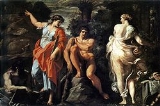
The Choice of Hercules
Encyclopedia
The Choice of Hercules is a painting by the Italian
Baroque
painter Annibale Carracci
. Dating from 1596, it is housed in the Capodimonte Gallery of Naples
. The subject is the Choice of Hercules.
Carracci, who was in Rome from the late 1595 or early 1596, was commissioned this work by Cardinal Odoardo Farnese for the ceiling of his camerino
in his family's palace
. In 1662 it was moved to the Farnese ducal seat in Parma
. The work is considered one of Carracci's masterworks for its balanced rendering of a poetical ideal, graphically influenced by the artist's contact with Michelangelo
's Sistine Chapel
frescoes and Rome's classical remains, such as the Farnese Hercules
or the Laocoon
group.
A vigorous and plastic Hercules
is depicted with two women flanking him, who represent the opposite destinies which the life could reserve him: on the left the Virtue is calling him to the hardest path leading to glory through hardship, while the second, the Pleasure, the easier path, is enticing him to the vice.
Behind Hercules is a palm, which, through the leaves and the branches (a symbol of military victory and fame), hints to Hercules' future heroic life.
Italy
Italy , officially the Italian Republic languages]] under the European Charter for Regional or Minority Languages. In each of these, Italy's official name is as follows:;;;;;;;;), is a unitary parliamentary republic in South-Central Europe. To the north it borders France, Switzerland, Austria and...
Baroque
Baroque
The Baroque is a period and the style that used exaggerated motion and clear, easily interpreted detail to produce drama, tension, exuberance, and grandeur in sculpture, painting, literature, dance, and music...
painter Annibale Carracci
Annibale Carracci
Annibale Carracci was an Italian Baroque painter.-Early career:Annibale Carracci was born in Bologna, and in all likelihood first apprenticed within his family...
. Dating from 1596, it is housed in the Capodimonte Gallery of Naples
Naples
Naples is a city in Southern Italy, situated on the country's west coast by the Gulf of Naples. Lying between two notable volcanic regions, Mount Vesuvius and the Phlegraean Fields, it is the capital of the region of Campania and of the province of Naples...
. The subject is the Choice of Hercules.
Carracci, who was in Rome from the late 1595 or early 1596, was commissioned this work by Cardinal Odoardo Farnese for the ceiling of his camerino
The Camerino Farnese
The decision to paint the ceiling of the Camerino instead of proceeding with the original plans for the Alessandro Farnese cycle Farnese Gallery was taken before the summer of 1595...
in his family's palace
Palazzo Farnese, Rome
Palazzo Farnese is a High Renaissance palace in Rome, which currently houses the French embassy and the Ecole Française de Rome ....
. In 1662 it was moved to the Farnese ducal seat in Parma
Parma
Parma is a city in the Italian region of Emilia-Romagna famous for its ham, its cheese, its architecture and the fine countryside around it. This is the home of the University of Parma, one of the oldest universities in the world....
. The work is considered one of Carracci's masterworks for its balanced rendering of a poetical ideal, graphically influenced by the artist's contact with Michelangelo
Michelangelo
Michelangelo di Lodovico Buonarroti Simoni , commonly known as Michelangelo, was an Italian Renaissance painter, sculptor, architect, poet, and engineer who exerted an unparalleled influence on the development of Western art...
's Sistine Chapel
Sistine Chapel
Sistine Chapel is the best-known chapel in the Apostolic Palace, the official residence of the Pope in Vatican City. It is famous for its architecture and its decoration that was frescoed throughout by Renaissance artists including Michelangelo, Sandro Botticelli, Pietro Perugino, Pinturicchio...
frescoes and Rome's classical remains, such as the Farnese Hercules
Farnese Hercules
The Farnese Hercules is an ancient sculpture, probably an enlarged copy made in the early third century AD and signed by a certain Glykon, from an original by Lysippos that would have been made in the fourth century BC...
or the Laocoon
Laocoön
Laocoön the son of Acoetes is a figure in Greek and Roman mythology.-History:Laocoön is a Trojan priest of Poseidon , whose rules he had defied, either by marrying and having sons, or by having committed an impiety by making love with his wife in the presence of a cult image in a sanctuary...
group.
A vigorous and plastic Hercules
Heracles
Heracles ,born Alcaeus or Alcides , was a divine hero in Greek mythology, the son of Zeus and Alcmene, foster son of Amphitryon and great-grandson of Perseus...
is depicted with two women flanking him, who represent the opposite destinies which the life could reserve him: on the left the Virtue is calling him to the hardest path leading to glory through hardship, while the second, the Pleasure, the easier path, is enticing him to the vice.
Behind Hercules is a palm, which, through the leaves and the branches (a symbol of military victory and fame), hints to Hercules' future heroic life.

